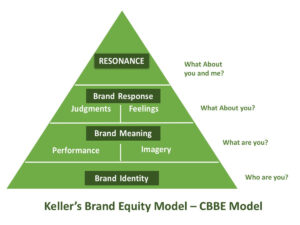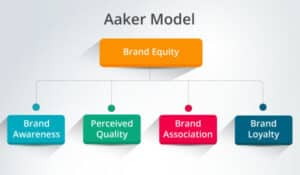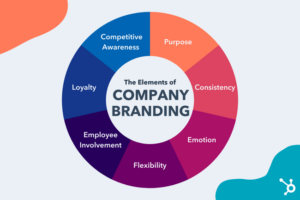The performance of every marketing channel your company uses hinges on having a clear and differentiated brand strategy.
If you don’t know who you are or what makes you unique, good luck trying to convince anyone else.
I know I know…”easier said than done Ken”.
True. Everything is. Rome wasn’t built in a day.
But that doesn’t mean you can’t put in the work and create your own version of the colosseum.
So how do you make that happen?
Well, before you can have a strong and eduring brand, you need a solid brand strategy, and contrary to popular belief, B2B branding doesn’t have to be stiff and boring.
The world has changed. Your buyers are consuming content in ways that would have seemed ridiculous five years ago. CEOs are learning about solutions from ChatGPT and Tiktok for goodness sake.
Your goal should be to create a B2B brand your target customers will love and remember. A brand that helps you achieve your business goals simply by existing.
There is zero room in today’s overcrowded, cutthroat market to be stiff, boring, and add nothing new to the conversation.
You need a real life brand roadmap that effectively cuts through the noise and gets you noticed.
Lucky for you, that’s exactly why we made this beautiful collection of morphemes — to help you create a B2B brand strategy that delights and converts.
For those of you that are impatient, here’s the 10,000 ft view.
B2B Brand Strategy Key Takeaways
- Clarify Your Brand’s Core Identity. Define your mission, values, and unique positioning. Ask: What do we stand for? Who do we serve? What makes us different? Write this down and make sure everyone on your team knows it.
- Develop a Brand Strategy That Drives Action. Identify how your brand will attract, convert, and retain customers. Outline key messaging pillars, brand personality, and the marketing channels you’ll focus on.
- Position Yourself to Win. Audit your competitors to see where you can stand out. Craft a positioning statement that clearly states why customers should choose you over alternatives. Update your website and sales materials accordingly.
- Ensure Brand Consistency Across Every Touchpoint. Align messaging, visuals, and customer interactions. Train your team on brand guidelines, update your website and social profiles, and create templates for social media and sales decks.
Oh you’re still here?
I like you. You want to really understand how this works.
Let’s quickly define what a brand really is.
What Exactly is a Brand?
Back in the day, cattle ranchers used to use a searing hot iron to leave an indelible mark on their cattle. Anyone who saw the mark knew whose they were.
That’s where the term branding came from!
As a business, you must leave a (preferably) indelible mark on everyone who comes across you. To do that, you must create positive experiences that will leave an impression.
So, what exactly is a brand?
In short, a brand is the sum total of the experiences and perceptions your customers have about you. It’s not just your logo and colors — it’s your ethos, how you operate, and how you leave people feeling.
What’s a Brand Strategy?
A brand strategy is the game plan for how your business becomes memorable, trusted, and the obvious choice in your market.
It’s not just a logo, a color palette, or a catchy tagline. That kind of thinking would be equivalent to calling an entire restaurant experience “just the menu font.”
At its core, a brand strategy answers three questions:
- Who the heck are you? (Your mission, values, and unique personality)
- Who are you talking to? (Your ideal customers and what they care about)
- Why should anyone give a damn? (Your unique positioning and the value you bring)
A strong brand strategy makes you more than just another option. It makes you the only option in your customer’s mind.
It’s the difference between being the company people stumble across and the one they actively seek out.
Brand-Building: Model vs. Strategy
Your brand encompasses everything that distinguishes you from the competition. It’s how consumers recognize you, how they perceive you, and, ultimately, why they choose to (or choose not to) give you their business.
Brand work digs deep into who you are, why you do what you do, and what it means to those you serve. But if you’re wondering whether you need a brand model or a brand strategy, the answer is this: You need both.
Brand Models
Think of it this way: A brand model (sometimes called a brand equity model or a brand essence) is your reason for existing. It’s your why. Why you do what you do. Why you’re the best at it. Why your customers choose you. Why your brand resonates with them.
Brand Strategy
A branding strategy, on the other hand, is your how. How do you win over your target audience? How do you market to their needs and wants? How do you create demand? And, perhaps most importantly, how do you deliver on your brand promises?
Building Your Brand Model
Let’s dig a little deeper — where do you begin with creating your brand model? It’s important to start with a brand audit, and you may want to consider using a brand marketing agency to help you begin and navigate through this process. Start by asking yourself the following questions:
- What are the key brand themes?
- What are the differentiators?
- How does the language you use support the brand?
- Are there areas of confusion?
At the end of the day, it’s all about perception. When you perform a detailed and thoughtful audit of your company’s brand, you gather tools that will help direct your brand strategy.
Once you’ve completed your brand audit, it’s time to start thinking about how you want to construct your brand model. There are two widely accepted modeling types within the marketing industry, and you can use either of these to lay the foundation for your own brand model:
Keller’s Brand Equity Model
The CBBE (customer-based brand equity) model is steeped in feelings. It asks: “How does the consumer feel about our brand at any given time in their journey?” To effectively use this type of model, you want to be making branding decisions informed by your mission, vision, and values. How are you communicating those? Do you live your values in a way that is obvious to consumers? Is your engagement with customers relational or transactional?

Source
Brands built according to this model are all about the warm fuzzies, but of course, that has to be grounded in a strong identity. Consumers often want to use a brand because of what it stands for but also what it says about them. For instance, someone who wears Tom’s shoes or drives a Subaru.
The Aaker Brand Equity Model
On the flip side of the coin, we have the Aaker Model, which is based more on consumer recognition. This model begins with awareness, but, of course, you must have top-notch quality to back it up. Once you wow consumers with your product or service, they make certain positive associations with your brand and eventually become loyal customers (or, even better, brand ambassadors).


Source
As an example, think back to the start of the article and the Nike swoosh or McDonald’s arches. They are instantly recognizable, and you know exactly what you’re getting when you purchase their products.
Of course, you can create a brand model that takes elements of both of these. However you decide to model your brand, you need to ensure you can bring it to life with your branding strategy.
What Is the Value of Building a Brand Strategy?
As we’ve mentioned, a brand is more than just a logo, name, or slogan. A brand is the entire experience that your customers have with your company, product, or service. It doesn’t just tell them what you do — it tells them who you are.
Your brand lives in everyday interaction with your audience and is highly visible in the following areas:
- Images you convey
- Messages you deliver on your website, social media, proposals, and campaigns
- Ways in which your employees interact with customers
- Customer’s opinions of you versus the competition


Source
Building a brand strategy is a critical early step in an overall growth marketing plan. As you begin putting together your strategy, here are a few points you’ll want to outline in detail:
Set Goals
Are you aiming for broad brand recognition, or do you want to create demand within a smaller target? Understand your goals at the outset so your strategy can provide the roadmap to help you get there.
Find Your Niche
Sure, you want everyone to love your brand, but narrowing your focus to a particular niche will enable you to be more strategic and will give you detailed insights into your customers, your competitors, and the market.
Conduct Market Research
Speaking of the market, you’ll want to do some in-depth research as part of your brand strategy. Make sure you include a competitor audit/analysis so you understand who and what you’re up against. Also, take a look at potential customers to find out what they’re looking for.
Identify Your Buyer Persona
Your buyer persona is going to be critical to your brand. While not every customer will fit into the parameters of your persona, you’ll find that there’s usually some overlap. Use a buyer persona template to get started quickly and easily.
Highlight Your USP
What do you do that no one else in the market is doing? That’s your USP (unique selling point). Depending on your industry and your product/service, your USP might be pretty obvious. But if you’re in a packed market with fierce competition, it might take some digging to uncover it. Once you do, make it an essential part of your strategy.
Develop Supporting Strategies
In addition to a brand strategy, you’re going to want strategies for the marketing channels you’ll be using to promote your brand. That may include content, SEO, lead/demand gen, social media, and more. You may want to choose one or two to start with. The key is making sure that your strategies all align and support the same goals.
Craft Your Brand Identifiers
Now for the fun. Consider your logo, brand colors, taglines and slogans, and any other visual identifier you’d like to use. Your research may have uncovered some insights in this area (e.g., the brands in your market almost always use the color blue), so consider that when designing your visual identity.
Stand Out from Your Competitors Today
Ready to differentiate your brand from your competitors and stand out from the crowd? By working with a growth marketing agency that understands the ins and outs of branding, you’ll develop a strong brand strategy that boosts your ability to attract prospects and leads.
With great brand development, you can:
- Set yourself apart as a modern brand that people love
- Compete with brands that have been around longer
- Motivate prospects to buy from you
- Create loyalty between your customers and your brand
- Increase revenue and retain customers with less effort
Get your brand story right and the revenue will follow because prospects understand what your product and company stand for.
Why Your B2B Company Should Care
Especially for B2B companies, it may seem as if branding isn’t really necessary as most transactions and interactions are between two businesses. However, branding is extremely important for B2B brands. Here are a few reasons why:
B2B Buyers are People Too
Underneath the titles and roles, B2B buyers are people too. This means they are influenced as much by emotions as they are by logic. A great brand appeals to both by:
- Clearly conveying the message of what you do.
- Pushing emotional buttons that make your brand leave a memorable impression on your audience.
Creating experiences that achieve the above two will help you generate more inbound leads (through word of mouth marketing) and improve your conversion rates.
Branding Influences B2B Buying Decisions
According to research, 52% of B2B buyers say their purchase decisions are influenced by the brand a salesperson represents. That’s why you must have a well-designed B2B brand strategy. After all, branding is essential to building trust with decision-makers in the companies you’re targeting. From your logo to brand colors to messaging and everything in between, your branding can make your target audience feel safer doing business with you.
Branding Establishes You as an Authority
Another reason why your company should invest in a proper B2B brand strategy is that it’ll help you build brand authority. This is where your customers and target audience feel confident in your abilities to deliver the solution you promise.
As you can see, branding is critical to your business. Without it, making headway in a competitive environment can be tough.
Elements of a Cohesive Brand
Now that you know how important branding is to your B2B brand, let’s quickly take a look at some of the elements that make for a cohesive brand.
Visual Elements
In many cases, the visual elements of a business are what most people consider to be the company’s brand. Visual elements play a big role in the way people perceive your brand, especially when it’s the first time they encounter your business. Examples of core visual elements that make up your brand include:
- Logo
- Color palette
- Typography
- Imagery
Getting your visuals right is essential as it leads to better brand recognition and awareness. For it to achieve that, however, you must ensure to maintain consistency across all platforms digital and offline.
Voice, Tone, & Messaging
While visual elements usually take the center stage in branding, the way you communicate with your customers is equally, if not more, important. This includes your brand:
- Brand voice. Brand voice refers to the personality your brand portrays in its communications. Your brand voice could be authoritative, funny and playful, professional, ominous, e.t.c.
- Brand tone. While brand voice is all about your brand’s personality, brand tone is how you express that personality. Your tone can change according to context and the type of content you’re creating.
- Messaging. This refers to the value proposition you’re conveying and the language you use to do so. Its main purpose is to encourage your target audience to get excited about your product.
Getting your communication style is an essential aspect of your brand. It plays a role in whether your verbal and non-verbal messaging resonates with your customers.
Purpose & Values
You can’t talk about branding without mentioning your purpose and values. That’s simply because they make up an integral part of your brand — who you are and the experience you offer your customers.
What do these two have to do with your brand?
- Brand purpose. Brand purpose refers to the meaning of your existence. It’s what you want to become to your target audience. It often has to do with the problem you solve and must be crafted in a way that inspires.
- Brand values. These are what you stand for as a brand and help with decision-making. Your values are also a core part of your culture as a brand.
To create a holistic brand, you must clearly define your purpose and vision. This will influence how you interact with your audience and inspire the design of your branding playbook.
Unique Positioning in the Market
The last element you need for a cohesive brand is a unique positioning in the market. Brand positioning is about finding your sweet spot in the market.
With so many businesses in the same niche, your audience is bombarded by many different messages. Brand positioning is what helps you stand out from your competitors. It differentiates you and makes your product more appealing to your target audience. Once you’ve found your sweet spot, it’s essential that you craft a positioning statement. This is a short description of your target audience and how you want them to perceive your brand.
With the elements of a cohesive brand covered, you’ve laid a solid foundation for developing your brand strategy. So, let’s dive right into how you can do just that.
How To Create A Brand Strategy
In the famous words of Dan Wieden, “People don’t buy goods and services. They buy relationships, stories, and magic.” Your branding is a powerful way of telling your story and forging solid relationships with your audience and customers. Brand strategy is the magic that makes it happen.
How do you create a B2B brand strategy that works that magic?
Identify Your Goals
The first step to creating your B2B brand strategy is to identify your goals. These can be quantitative (like $15M ARR) or qualitative (establish yourself as an authority in your niche).
Identifying your goals is made easier when you’ve already defined your purpose and values as well as understanding your unique positioning in the market.
Without well-defined defined goals, your brand strategy will be misaligned and won’t achieve its purpose of increasing your:
- Visibility
- Engagement
- Conversions
So, make sure to sit down and get this aspect of your brand strategy sorted before you do anything else.
Define Your Target Audience
Defining your target audience is another crucial step in designing your brand strategy.
One thing to remember as you define your target audience is that you have to target two levels:
- Ideal customer profiles (ICPs). This is a representation of the types of businesses that will benefit most from your product or service.
- Decision-makers. These are the high-level individuals responsible for making purchase decisions on behalf of the business.
However, your primary target audience as far as branding goes is the decision-makers. To better understand them, you must dig deep into their:
- Demographics. These are physical traits that are common among your target audience. Examples are location, gender, position in an organization, and much more.
- Psychographics. These are psychological traits found in your target audience. Examples include interests, values, aspirations, opinions, activities, among others.
With the demographic and psychographic data you’ve collected, you can now build personas to better understand the decision-makers you’re targeting. Your personas must include detailed, relevant information about each stakeholder. Identify their:
- Role in the buying journey
- Goals
- Needs
- Fears
- Frustrations
Defining your target audience is critical as it will help you refine the four elements of a cohesive brand mentioned above.
Decide on Key Channels
Once you’ve defined your target audience, the next step to creating your B2B brand strategy becomes easier — defining your key channels.
The purpose of creating a brand strategy is to increase your business’s visibility and memorability. To achieve this, you must identify the key channels your target audience frequents. This makes it easier for you to position yourself strategically. Common channels you can leverage include:
- Social media
- Paid advertising
- Content marketing
- Organic search
- Conferences and trade shows
- Out of home (OOH) advertising
Deciding on the right channels will ensure successful brand awareness campaigns. It will also help you achieve the goals you set in the first step.
Identify Content Opportunities
Content marketing plays a huge role in your brand strategy.
But with so much information bombarding your customers, how do you ensure that yours gets noticed?
You must discover and take advantage of content opportunities.
A few ways to find content opportunities include:
- Conduct keyword research. Find keywords your target audience uses when searching for the solution you provide. Create content around these keywords to boost your search rankings.
- Spy on your competitors. Check out your competitors and find out which content pieces perform best. This will give you an idea of what to publish on your website.
- Identify content gaps. Scour forums, social media, and other platforms to identify content gaps, or topics your target audience are looking for yet very few websites have published. Even if those topics don’t drive much traffic, they are crucial to bolstering your content and brand marketing.
- Identify guest posting opportunities. Guest posting is the practice of publishing content on other sites. Identify websites your target audience visit and publish value-packed articles there.
- Brand partnerships. Look for businesses in the same niche as you but aren’t competitors. Get listed on their partnership pages to boost your brand awareness.
A well-executed content strategy will help you achieve your branding goals, particularly establishing yourself as an authority in your niche. It can also help drive your lead generation efforts, thereby growing your customer base.
Stand Out from the Herd
Another foundational purpose for creating a B2B brand strategy is to help you stand out from the herd. Particularly in a crowded niche, you need to create assets and experiences that will differentiate you from your competitors.
One of the best ways to do this is to create a brand personality.
Brand personality simply refers to human attributes and characteristics that give your brand a human touch. It helps your customers better relate to your brand. To create an effective brand personality that helps you stand out from the herd, answer the following questions:
- Who is your audience?
- What consistent set of traits do they love?
- What emotions best drive conversions and sales?
Defining your brand personality will help you be in control of how your customers perceive your brand. It also helps you create memorable experiences as your customers interact with you on the buyer journey. This is important as it will result in your relationships with customers superseding just the transactional aspect of a business. You will win their loyalty, resulting in them becoming brand ambassadors.
Don’t know where to start? Create a team page. People like to see who they’re working with!
Measure, Analyze, Improve
As with all strategies, tracking performance is crucial. That’s why your B2B brand strategy must include measuring and analyzing performance and improving aspects that aren’t doing so well.
How do you measure the success of your brand strategy?
Simple. It starts with the goals you set. Use those goals to define key performance indicators (KPIs) you can use to track your campaigns. Examples of tools and KPIs you can use:
- Use Google Analytics to track traffic to your website (direct and referral).
- Use social listening tools like Buzzsumo to track your earned media value.
- Measure backlink success using tools like Ahrefs, Moz, and SEMrush among others.
- Track social media engagement using each social media platform’s analytics dashboard.
- Use surveys to track where new customers are coming from and whether they’re likely to refer you.
Keeping an eye on how your brand strategy is performing will help you refine your strategy. Make sure to develop a methodology for brand measurement, track your key KPIs, and analyze your data.
Brand Marketing — The Key to Business Growth & Success
Getting your business in front of the right audience is critical to your success. A well-executed B2B brand strategy will help you achieve that and more. At the end of the day, it’s your branding that helps you:
- Attract the right audience.
- Convert them into paying customers.
- Recruit them to be your brand ambassadors.
This makes brand marketing an essential aspect of business that you must invest in.
Ready to take your B2B brand strategy to the next level?
Get in touch and let’s have a chat or view our verbal brand identity & messaging page to learn more.


